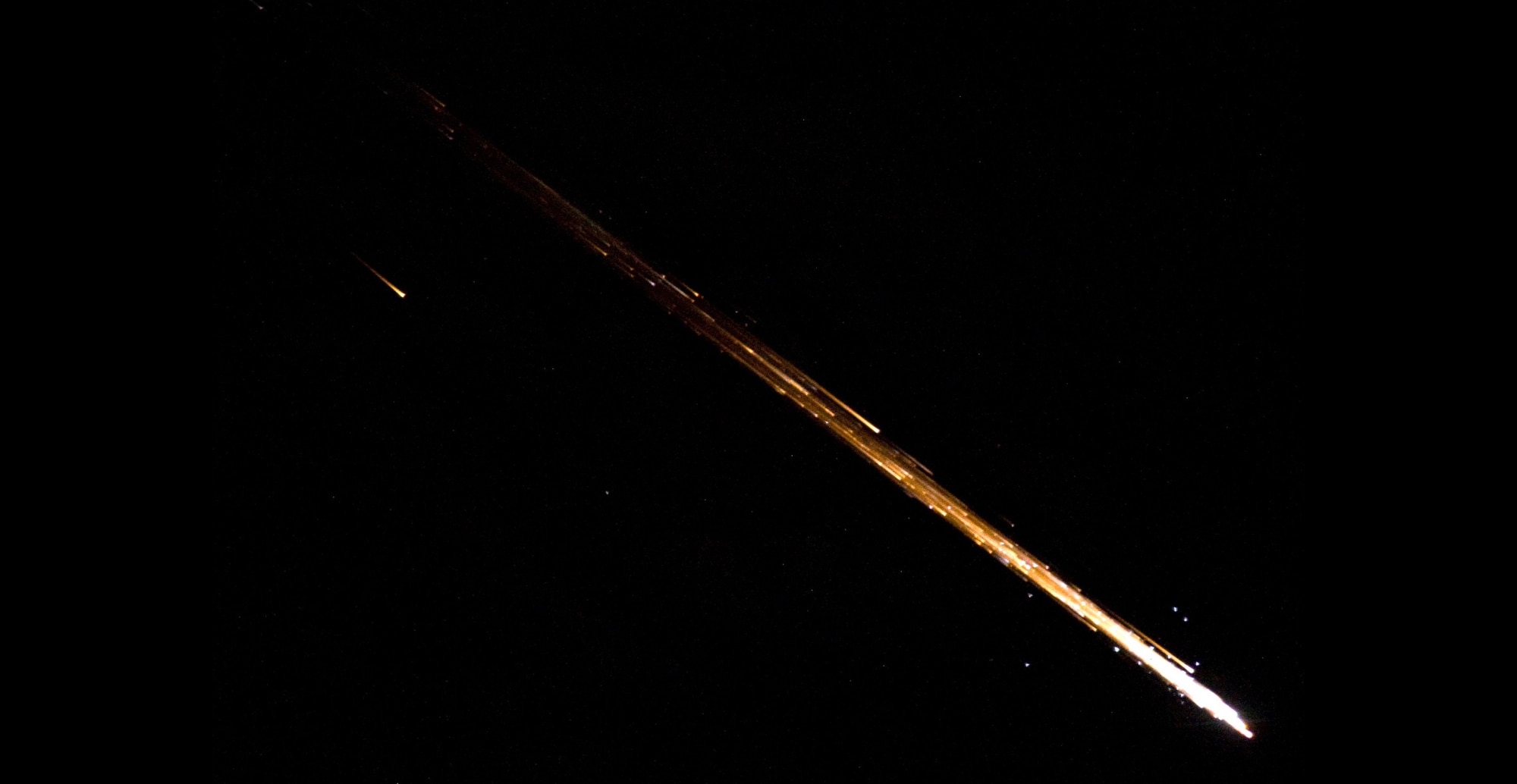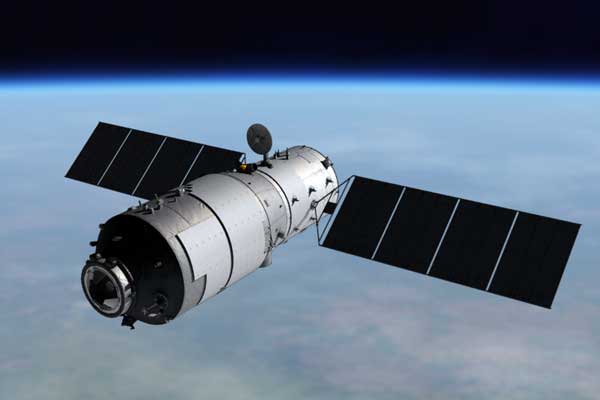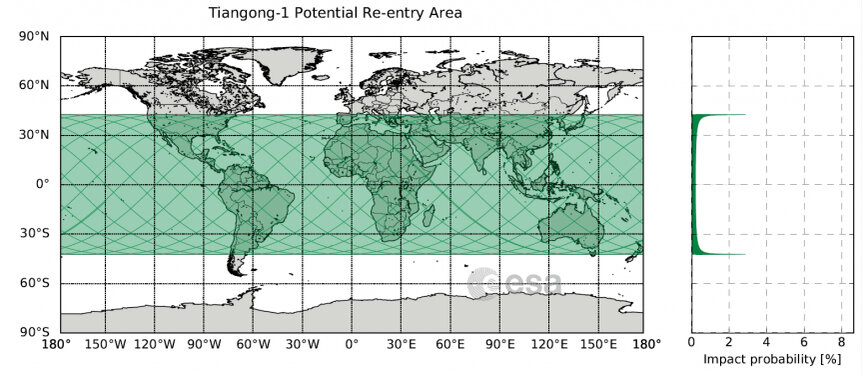Create a free profile to get unlimited access to exclusive videos, sweepstakes, and more!
When heaven and Earth collide: The fall of Tiangong-1

Sometime over the next few weeks the small Chinese space station Tiangong-1 will re-enter Earth's atmosphere and (mostly) burn up.
The big questions are where and when. Unfortunately, because we don't know when, we can’t know where. The most likely date is around April 1, but the timing is uncertain — and because of that, we don't know where it will come down.
We also don't know how much of it will make it to the ground, but the better news is that the majority of it will burn up. It's unlikely very much will survive to make it down. It's also unlikely it'll happen over land, and even less likely it'll come down over a populated area.
I know people fret over things like this, so to be clear, the chances of you personally getting hit by any pieces from this event are extremely small, far less than getting hit by lightning. You should be a lot more worried about, say, slipping in the bathtub.
If you want more information please take a look at the European Space Agency's Tiangong-1 re-entry FAQ, but what follows is my take on it.
Tiangong-1 is the first in a series of increasingly bigger and more complex space stations planned by China (Tiangong-2 launched in 2016, and a third station is planned for launch in the next few years). Tiangong-1 — which means "Heavenly Palace 1" — launched into low-Earth orbit in 2011, over 350 km above the ground. It's about 10 meters long and has two modules: a service module (with solar panels attached for power and engines for station-keeping) and an experimental module with a docking port and the like for a human crew to get on board and stay for short visits.
It was visited three times by the Chinese National Space Agency: an uncrewed vehicle a few months after Tiangong-1 got into orbit, then twice by crewed vehicles to test various systems and get practice for the later, more ambitious space stations.
Contrary to popular belief, there is air at that height above the Earth, though it's extremely thin. Still, a spacecraft orbits at roughly 8 kilometers per second, so even the tenuous atmosphere at that height produces drag. This steals orbital energy from the spacecraft and lowers its altitude, enough that periodic reboosts are necessary. The service module on Tiangong-1 carried enough fuel to perform those boosts, raising the orbit.
However, CNSA reported in early 2016 that they had lost control of the space station and could no longer do the reboosts. Because of that, the orbit continued to drop. As of today it's about 235 km above the Earth's surface at closest approach (the orbit is slightly elliptical, with an apogee [max height] of about 255 km). The more it drops the thicker the air it moves through, so the decay accelerates. The rate of decay depends on a large number of difficult-to-model variables, like height profile of the atmosphere (which can depend on solar activity), the cross-section of Tiangong-1 as it moves, and more.
Because of this, the predictions for when it will finally burn up are at best approximate. As of late 2017 it was thought it might come down as soon as early March, but over time the predictions have been converging on early April. Still, it could be late March to late April. The only way to narrow the window is to wait and see how it behaves.
The orbit of the station is tilted to the Earth's equator by about 43°, so it could burn up anywhere from 43° south of the equator to 43° north. That’s literally more than half the planet! However, most of that area is covered by water (the Pacific, Atlantic, and Indian Oceans), and most of the land in that zone is sparsely populated.
There are a lot of population centers in the zone, but remember, they are small and the Earth is big. As my friend, fellow astronomer, and space enthusiast Jonathan McDowell pointed out in a series of tweets, the odds of it hitting in any one spot are very low. Because of geometry and trigonometry, the odds are higher at the extreme north and south parts of the orbit, because Tiangong-1 spends marginally more time there than over the equator. But even then the odds are extremely low.
Because of all these uncertainties we don't know where this will happen. Remember, it's moving fast. A prediction off by a single minute means a downrange track change of 500 kilometers! And we don't even know what day it will come down just yet, so it’s far too early to guess where it will hit (except that it’ll be between the two latitude extremes, since it can’t reach farther north or south than those).
So what will happen when it does come down?
As it re-enters, it will heat up. This is due mostly to it ramming through the atmosphere at high speed. When you compress a gas it heats up, and this will be compressing the air a lot. At some point as it drops lower this heating will be so extreme that parts of the space station will heat up enough to glow. The dynamic pressure will also rip it to pieces, so it will fall apart even as it vaporizes.
A lot of the station is fragile and will burn up completely. Weirdly, what survives is hard to say exactly. Very dense things with high melting points tend to survive re-entry. However, so do very lightweight things, because atmospheric drag slows them so rapidly that they don’t get a chance to burn up. Empty fuel tanks are a common survivor of these events. As it happens, the Chinese lost control of the station before all the fuel was used up, and this may be a boon: It makes the tanks heavier, so they may get more of a chance to burn up.
It may also cause the tanks to explode, but if that happens that may also be beneficial; that makes lots of smaller pieces with more surface area, so the station burns up better. Like I said, this is pretty complicated.
One way or another, it'll be a spectacular sight. A lot of satellites and other spacecraft have burned up over time, and recently we've seen more videos and pictures, some even taken from the International Space Station. It's like a slow-moving meteor, a large blob of light with a long, streaking tail, with smaller bits leaving their own trails as pieces fall off.
In many of those cases, I'll note, the spacecraft are de-orbited carefully, controlled, so that the debris falls over the Pacific Ocean, the largest uninhabited region on the planet. As much as I'd like to see footage of this for Tiangong-1, my hope is that this also happens over the vast expanse of the Pacific Ocean, where no one will see it at all! That will minimize any danger, as low as it already is.
And I hope the Chinese learn from this as well, and their next generation of space stations has a happier fate.
I'll follow up this post with more as it comes in; you can also follow me on Twitter. Jonathan is also a wonderful source of canny and up-to-date info, as well as insight into what's what.




























